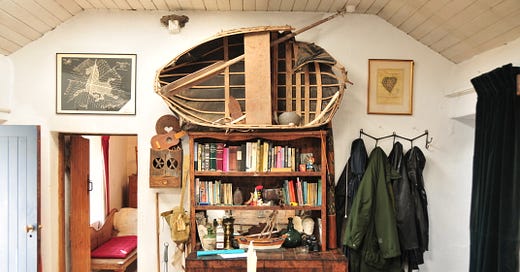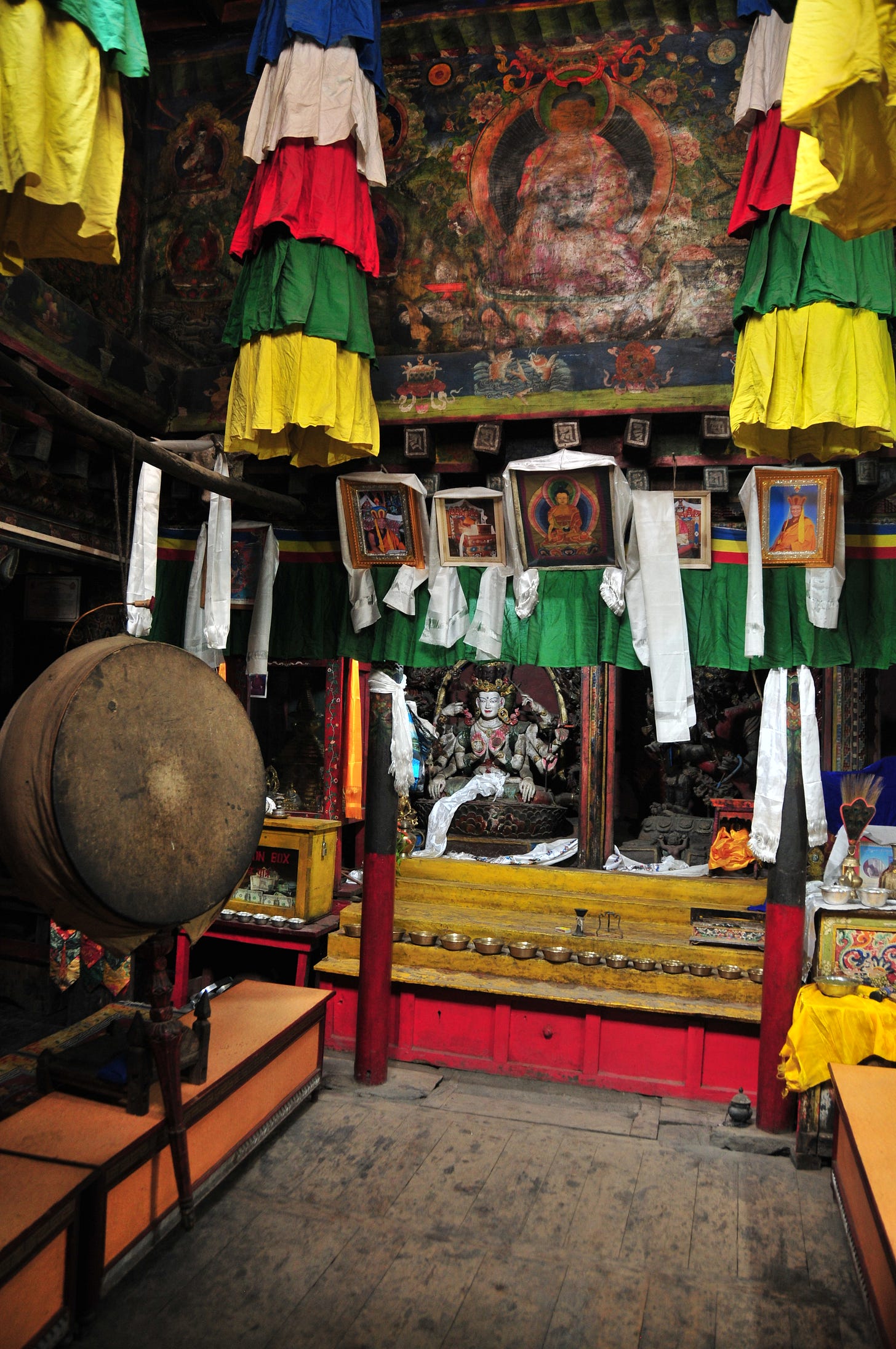hand drawn maps of strangers
Cabinets of curiosities and wonder rooms, and what to bring home from a trip.
-Journal entry: May 1, 2024, Village of Jomsom, Kingdom of Lo, Nepal
The monk unravelled silk cloth wrapped around 5 sacred objects, a covered treasure chest under lock and key. Inside: a boot of a religious leader, a miracle stone he pierced with a stick, a human skull plate; objects that are coveted and loved and used to bring to life a connection with the blessed. Objects of spiritual and metaphysical value. It reminds me of Graceland and Elvis, or an old guitar pick I kept from a concert once seen, a totem that anchors lived experience, the physical placing of a memory. There is something akin in the keeping of things to having some sort of connection with a time, a person, an idea; small bits of magic full of primitive fears and pieties.
The distinction between symbol and actual is not clear in this part of the world, a statue is an extension of that which it represents, and is treated as such. Paintings of things are, in part, the thing itself. Ideas as well come to life in ritual, song, and dance in these Himalaya. Grains of colored sand are periodically placed in geometric collections and patterns mapping out imagined temples and houses for the gods. These are called mandalas, and are mind maps of heavenly spaces. Usually these mandalas are about the size of a pool table and take weeks to finish prior to a ceremony or puja. Not only that, but a mandala will bring to life a place to house gods and spirits for specific rituals. It is both a map of space and the becoming of the space in the metaphysic; necromancy, wizardry: something tangible with a physical reality of its own.
I recently traveled to Ireland with the goal of accessing something similar to those sacred objects of Nepal. I had been to Ireland so many times before, lived there for a time, but had all been through a lens of modern tourism and travel that I felt held hostage to a certain point of view, to something foreign to the actual, an accessory to place.
Not long ago I read an article about a trip to Switzerland where the author had no arrangements or bookings, and simply walked from one valley to the next each day, with the goal of traversing the country in 12 days or so. Each day at the end of the previous walk, the author would search for someone to hand draw a map to get to the next valley, and in this way spent 12 days walking from one end of the country to the other. There was something so pure in this, so immediate, so authentic; that horribly overused trope. I recognized it as the thing so many tourism mechanisms try to recreate in a controlled state, mimic, like a theater will recreate a setting for the stage. I wanted to figure out how to get to this again so I could understand and remember it, how to access it more, how to teach it and use it in trip planning. I wanted to come back with a handful of ways to spark a thread to drive a trip into these waters, as opposed to glossy photos and spa menus. I found myself wanting to come into direct physical contact with this sort of experience, and I wanted to bring some of this back.
This feeling of wanting to hold something, covet it, and bring it back, I recognized, it wasn’t unique to me, it is something we have all done and continue to do, something built into being human. I wanted to understand more.
I have spent a lot of time lately thinking about museums, how they work, where they came from, and this provided an explanation.
Humans have always collected things. There are ancient cave dwellings with shark teeth found that come from deserts thousands of miles away, things that were traded for inherent value. Greek muses were worshiped in houses called Museums (the particular entomology for this word being “house of muses”), places of inspiration.
In the Renaissance this word made a comeback but in the form first of small collections individuals would have from recent travels, small museums. They were stored in cabinets or small rooms and were called Cabinets of Curiosities, or Wunderkammer: wonder rooms.
It was the trend for the wealthy to go on a trip and collect things, objects, art, artifacts, and crafts to bring and spark conversations and study in their wunderkammers back home. Some sort of shift was omni present in culture in these days, philosophy had changed and the idea of the new Sciences were emerging. You can see this in the writings of Francis Bacon and the idea of philosophy being about going out rather than sitting in a dark room engrossed in contemplation. A universal natural history and categorization. Travel was central to this new science, we must go out to get things and bring them back to study and look at. The frontispiece of Bacon's book Novum Organum (1620) had in latin across the page: “Many shall go to and fro, and knowledge shall increase”, a quote itself from the Book of Daniel (12:4). Travel is linked with the success of the new sciences, with the wonder rooms, a going out must begin.
The grand tour was born from this, the gap year taken by the privileged where one would travel through Europe and the holy lands to bring back art and stories. A certain bacchanalia would happen as well, what happens on the grand tour, stays on the grand tour. The grand hotels of Europe were built to house this market, guide books were written to advise. As modern organized travel began, so too did the large museums of the world. The collections and Wunderkammers began to grow in size, and buildings were needed to house the curio’s. The Ashmolean Museum in 1683 was a collection of Cabinets of Curiosities by Elias Ashmole donated to Oxford for the hope of study and knowledge. Something learned from the objects themselves. With objects brought back came ideas and influence; architecture, fashion, music, much like the Silk Road years before.
There are objects of individual meaning, and there are objects created for commerce. These are, instead, symbols of consumption. ‘Souvenir’ is, of course, of latin origin, meaning "occur to the mind." The things sold at airports bring little to my mind, but the objects found along a trip, things that are autobiographical, those objects hold beauty. I think, somewhere along the way we forgot the origin of things collected, that they are autobiographical at best. The impulse is still there, people collect pebbles from travels, something physical to ground a time period, to remind to tell and house a story. It is easy to purchase something on a trip that will hold none of these things, and it happens often. The best things I have collected from travel have depth, story, history; they house my memories. These are objects of place, they hold some sort of magic that can be translated, these objects are my hand drawn maps collected, my cabinet of curiosities, my mandalas.









